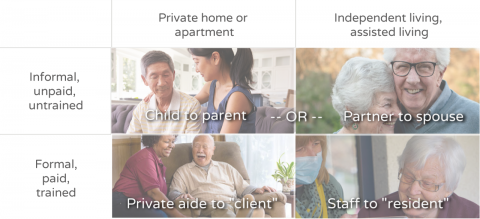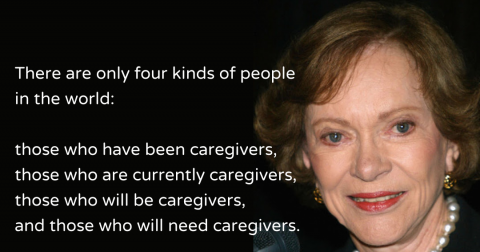It's easy to see the fragmentation in eldercare today. Like the our healthcare system as a whole, so many of these services seem to be optimized around service delivery, commercial transactions, compensating for deficits -- fixing what's broken -- rather than keeping us well. It's as if these services were designed around coping rather than caring, despite the nomenclature.
On the other hand, although it can be more difficult to see, there is plenty of eldercare that regularly takes a broader and more holistic view. There are caregivers of many stripes who every day and day after day go above and beyond the biological needs and physical security of the individuals in their care. They're also motivated to ensure their social, psychological and emotional wellbeing, as well. It's not surprising to hear these caregivers referring to themselves not just as 'caregivers' but also as 'companions.'
This caregiver-companion connection turns out to be pretty important. Just naming this dimension of the relationship can change it. It helps us see the critical role of conversation, stories and human connection in the context of caregiving, for example. Companionship is (or should be) an essential part of caregiving. And by calling attention to it we see what all kinds of caregivers have in common with each other... and also what the rest of us have in common with caregivers. Isolation and loneliness are problems for everyone at one time or another. And companionship has the potential to connect us all.
At first glance, there is precious little that caregivers have in common with one another or the people they serve besides the term 'caregiver'. The term is so broad that it would seem to include virtually everybody. Think about it. Can it actually refer to a person who attends to someone else? As a category, it is an odd designation, though. Who among us would say they don't care for others? And yet, many of us would reject the appellation 'caregiver' even when it does actually apply to us. And despite those of us with misgivings, there are many others who willingly embrace the role with joy, pride and even gratitude.
And how do we feel about receiving that care? We all know people who don't accept help willingly, who resist the assistance of a caregiver long after they could use it. Why do you suppose that is?
It seems we are somewhat conflicted about caregiving.
Perhaps we're missing something important: failing to see profound and common dimensions of the human experience that make caregiving relevant for all of us. Maybe we're overly concerned with superficial differences that divide caregivers into specialized roles and distinguish us from them. This is not just a rhetorical question, an intellectual exercise: understanding what underlies this vital work could enable us to collaborate, to provide better care, and perhaps even to derive more satisfaction from caregiving. Unpacking the caregiver-companion relationship is key. Let's consider each relationship in this extraordinarily broad and heterogeneous group.
From the point of view of the care recipient, the care we're talking about is self-evident. Caregiving is essential to daily living, if nothing else. Helping fulfill basic biological needs and physical security, it's immediately apparent that caregiving can be literally a matter of life and death. But how can we discuss the quality of care, the difference between mere survival and the extension of a dignified, purposeful and meaningful life that can sometimes last for years? That makes all the difference in how the care recipient feels about it. Whose job is that? How can we also include that quality, whatever it is, in examining the role and work of the caregiver?
Different Kinds of Care and Caregivers
When we turn our focus from the recipient of care to the caregiver, it gets more complicated. From the point of view of the caregiver, there are many different kinds of caregiving, so different, in fact, that it's hard to see exactly what they have in common. For example, there are between 40 and 65 million informal caregivers in the United States (depending on how the role is defined). They are are unpaid, untrained, caring for a parent or spouse, sometimes for years at a time. For some of them, caregiving is simply a given, an unquestioned aspect of being a child or a spouse, part of a family: it's what you do when a family member needs help. For others, it's also an aspect of family life, but an unwelcome obligation, a duty. (Despite what these informal caregivers have in common, the chasm between them is vast, often destroying families as their differences emerge). And finally, complimenting millions of informal, family caregivers, there is a wide variety of paid, formal caregivers with many different kinds of training and commercial relationships to the work. For these caregivers, there's also an employer: it's a job.
In addition to motivation, money, training and the context of employment, the physical venue of caring for another also tends to divide caregivers. Caring for an individual in their own home or apartment can be quite different from being on staff in some kind of facility, whether it is independent living, assisted living, a memory unit, adult daycare or skilled nursing. These differences can help us visualize a kind of caregiving matrix, grouping caregivers based on their relationships to the care recipient and where they work.

In addition to what the care consists of, how and where it is being provided, we think a lot about the kinds of relationships caregivers have when we divide up the universe of caregiving. A partner caring for a spouse, for example has resources and abilities that a child will not have. Caregivers who are related know things about the person they are caring for that an in-home caregiver or staff member might not have access to. Meanwhile, formal, paid and trained caregivers have skills, experience and support resources that family members don't have. What we're really talking about here are different kinds of caregiving relationships, each of which presents unique challenges and comes with different kinds of resources.
One reason we fail to appreciate what's common to all of these types of caregivers is that we do our best to pathologize and commercialize aging instead of humanizing it. In other words, we focus on distinct disabilities and specialized treatment instead of common needs, abilities and relationships we all experience with aging. It's no wonder our relationship with caregiving depends so much on our point of view: as consumers, care recipients and caregivers alike in each of these categories, we are highly attuned to the differences which define products and services we consume and the boundaries marking the transitions where one's own responsibility ends and the work of others begins.
Another reason we may not appreciate what connects all of us to caregivers is our relationship to aging itself: we don't like to talk or think about it until we have to. We tell ourselves that aging is for "those other people." But that's wrong; in fact, we are all aging, all connected. Rosalind Carter said it best: "There are only four kinds of people in the world: those who have been caregivers, those who are currently caregivers, those who will be caregivers, and those who will need caregivers."

But the former First Lady is missing another even larger category of people touched by caregiving: the people who care for the caregivers. It is indeed all of us. We all are (or will be or will care for) caregivers.
All of this is important. We fail to see how everyone is connected somehow to caregiving, how central it is to the human experience. We struggle to see how all the different kinds of caregivers are, in a very fundamental way, working to achieve the same goal. We know chronic disability and care isolate seniors and their caregivers, putting them at risk for feelings of loneliness, depression and other affective disorders. But there's a real danger in reducing caregiving in this way to the 'provision' of something that is missing, filling a 'gap' as it were. Caregivers DO provide essential services. And how that service is delivered together with specific caregiving relationships DO in fact differentiate different kinds of caregiving. Nevertheless, there is one often overlooked aspect of caregiving that brings all of these experiences together and can give us hope: to some extent, caregivers all become de facto and often essential companions.
Companionship is an Essential Element of Caregiving
When we look closely at companionship as an essential element of care instead of taking it for granted, it changes everything. As companions, they are doing a lot more than compensating for a DIS-ability. By definition, companions accompany one another, mutually engaging their ABILITIES, whatever they may be. As companions, each in their own way, all caregivers are looking to mitigate the social and emotional isolation that so often accompanies aging and disability in our society. And as companions, all caregivers are looking for ways to engage the individuals they care for in meaningful and authentic ways. In other words, our mutual need to engage one another, to provide companionship, to connect, can create a kind of bond between caregivers, allowing for exchange, collaboration, mutual support, and respect.
Companionship is also a fundamental way that caregivers themselves experience intrinsic rewards from caregiving. In any case -- whether it's a an obligation or a job, whether it's work in a private home, a senior residence or a nursing facility -- companionship in the context of care can be deeply satisfying, rewarding, an experience of a lifetime. In one study I read from AARP, over 40% of family caregivers reported that caring for a parent or a spouse was the most meaningful experience in their lives. And for many professionals who are passionate about the work, it's the relationships with individuals that stay with them, that motivate them.
I sometimes wonder if thinking about aging and caregiving in this way can affect us. I wonder if caring for our elders and engaging them as companions might bring us together, to unify us, as a society. How can it not?
Being a good companion is not always easy. But it is good work, something we can actively do to mitigate loneliness and isolation in people we love and care for. It's worth remembering that this work is good for us too. It helps us pay attention to life itself, our own mortality, the human condition. And it helps us focus on our common values, bringing us together. As we all age and begin to need assistance with daily life, helping one another -- even simply being together -- can give us purpose, a reason to live, and the ability to live well, care recipients and caregivers alike.
We all need caregivers.
We are all caregivers.
And we're all seeking connection.
Press on this link to have Meema tell this story another way. Share it with a friend or companion. Talk about it.
